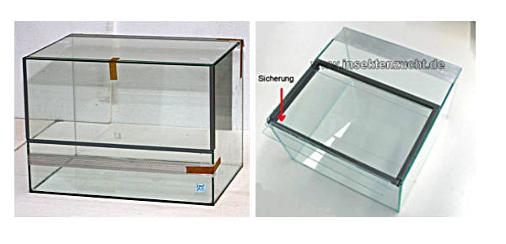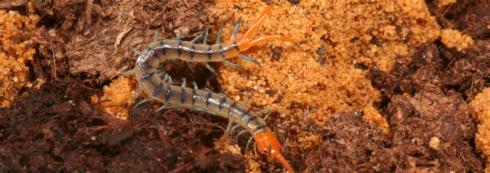Keeping Chilopoda
There should be some serious considerations before purchasing a centipede as a pet. Never forget that Centipedes are poisonous, very fast and real good escapees!
- do you live in a multi-family-house? rented flat?
- are there small children in the same household?
- do the other family members or cohabitants support your intention?
- do you feel equal to handle this fast and poisonous animals?
- do you have any terraristic experience (like scorpion, tarantula)?
If you checked out all this questions and you are still sure to keep a centipede as pet, there are some important informations:
Terrarium/Container
There are many useful possibilities for housing a centipede according to its size and living conditions. As a general rule, the minimum container size should be
length - 2 x length of the chilopoda
width - 1 x length of the chilopoda
height - 1,5 length of the chilopoda (or more, if there is high substrate)
(Attention! The Scutigeromorpha need bigger containers as they are small but very active in all dimensions!)
If you prefer a glass container or terrarium, please take care for useful doors. In the terraristic commerce, you can buy containers with upright doors (left picture) or containers with the door in the top cover (right picture). Using glass containers is the most beautiful solution. In that, you can make a natural and nice looking set-up and have the possibility to watch your pet from all directions.

In case of keeping a lot of centipedes, many people use pvc containers like "firstplast" or any other useful enclosures.
Set-up and arrangement
Chilopoda all live hidden, so the terrarium or enclosure must have hiding places. For centipedes, the most important hiding place is the substrate. The substrate level must be high enough that the centipedes can dig in. Therefore you can use humus or a humus-sand mix - according to the habitat, the species lives in naturally. Take care, that the substrate can save humidity - but take also care that it won`t get too wet at all. The best way is to use a enclosure big enough to create some zones which are more humid then others, so the centipede can choose itself the best place.
Other hiding places are pieces of bark, moss (very useful as it keeps humidity!), branches, stones, cork and other things. This things should be big enough that the whole animal can hide under it and the things should be placed in a way, that it cannot smash the centipede when it undermines them.
Some robust plants will complete the arrangement and give the enclosure a natural and pretty appearance.
Technics
There is not much technics needed to keep centipedes. If you have a good place at your home where it is well-tempered, it will be enough for the centipede. They don`t need special light. So the two most important things is keeping thecentipedes warm but not too hot and damp but not too wet. But with some experience, this will work without the use of much technics.
Food / Water
In the wilderness, the centipedes have a wide range of prey. Insects, spiders, snails but also mice, birds, frogs and lizzards depending on the size of the centipede.
In the containers kept as pets, they can be fed with insects like crickets, grasshoppers but also with young mice or meat.
As the centipedes must hunt their prey in nature, it is important not to feed them too much. Maybe once or twice a week is enough.
Most centipedes like to drink water from a small bowl or water drops from leaves.
Sexing / Mating / Rising
Although again and again there are offsprings available in commerce, the most of them are fortune by importing pregnant females.
Breeding centipedes is not easy and has some difficulties:
The first difficulty is, that it is very hard to sex centipedes. There are some species with external sexual characteristics but the most species have none. In my opinion, the main reason for cannibalism is to put the wrong genders together.
The second problem is, that it is not easy to get a pair of centipedes because they are still not common in hobby and thereby often hard to get and expensive. Who wants to try to mate a centipede which is maybe more then 50,00 Euro - always with the risk for losing one of the centipedes by cannibalism. It is not easy to find out the right time to mate them and also it is not easy to decide how long the two centipedes should be kept together.
The third problem is breeding the eggs and rising the young centipedes. As a centipede keeper we must accept, that most of the time we will not see our pets but (and that is the way I handle it) once a month the containers should get checked if the centipede is still alive, in good condition and inside the container.

So maybe we dig out the centipede and observe that it has eggs. That might be a big disruption for the centipede and can be the end of the breeding.
If the pedelings hatched out, they are in the same container as the mother - still with the risk that the mother considers the pedelings as prey. Shortly after the hatch, I seperate the mother but let all pedelings together in the container. Therein I keep them some weeks until the first molting. Of course I accept taking a loss by cannibalism but the mayority of pedelings survive in a above-average health condition.

The pedelings of many species have totally other colours then the adult centipedes (the picture above show a pedeling of Scolopendra cingulata var. obscuripes).
Conclusion:
Centipedes are very interesting and thankful pets, if you don`t forget this articles:
1. Centipedes are venomous, fast and incalculable. Ever handle with care!
2. Don`t be nervous or afraid, if the centipede burrows and hides for some days or even some weeks. That`s normal.
3. Don`t let them dry out but beware of keeping them too wet. This is one of the most common reason for death.
4. Don`t feed them too much.
5. Try to disturb the centipede as little as possible.